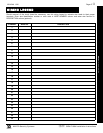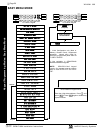
X GEM-P1664 Installation Instructions
L NAPCO Security Systems
WI1424A 1/06
Page 54
Duress Code. The panel will not allow duplicate User Codes to be programmed. Every user program code may now be
selected as an Ambush Code for Area 1 or Area 2 by entering a _5 in the Area 1 Options or Area 2 Options respectively.
Note: Keypad(s) must be enabled for Ambush.
New Operation of the Panel
Cross Zoning. Required Option for cross zoning with either programmable time period or specified by manufacturer. De-
fault is disabled. The existing programmable by zone feature "Zone ANDing Groups" are available for the cross zoning
option required by CP-01. This feature is not enabled in the factory program and not enabled when Enable CP-01 Features
are enable in the Easy Program Menu. Cross Zone set time = one (1) minute.
Pre-existing feature
Swinger Shutdown. Zone will only trip once and will not restore automatically. "Auto-Reset" (Addresses 0917, 0981,
1045, 1109, 1173, 1237, 1301 and 1356) and "Swinger Shutdown" (Addresses 0918, 0982, 1046, 1110, 1174, 1238, 1302
and 1366) are disabled in order to meet the CP-01 requirement of only one alarm activation per zone during an arming pe-
riod. These features are not selected on zones 1-8 in the factory program and are removed from all zones when "Enable
CP-01 Features" is selected in the Easy Program Menu. In a SIA CP-01 installation, these options must not be selected.
Auto-Reset must be programmed for all burglary zones in a UL Installation. See the glossary entry, "Swinger Shut-
down" in this manual.
Pre-existing features
Fire Alarms. Fire Alarm Verification available option on Fire Zones. Default is disabled. The existing programmable option
"Fire Alarm Verification" is available as required by CP-01. This feature is not enabled in the factory program and not en-
abled when "Enable CP-01 Features" is selected in the Easy Program Menu.
Pre-existing feature
Call Waiting. Disable Call Waiting on 1st Attempt. Default is disabled. When enabled, the telephone number must
be programmed with *70 in front of the telephone number. The first attempt will dial with *70 (disabling call waiting).
Subsequent attempts (if first attempt is unsuccessful) will dial without *70. Note: The digits used to disable Call
Waiting may vary with location. Be sure to confirm with local telephone company. Note: Disabling Call Waiting on a
non Call-Waiting line can result in a delay in the connection to Central Station.
2053, Bit 5 (see Note 2)
(2053 ·····6 ··)*
(2053 2 ·)**
System Test. Test Mode for all zones, the sounders, and communicator. The "Fault Find" function (a Function Menu
selection) is enabled, and normally causes all hardwired zones to give a two second beep at the keypad(s) when any
zone is faulted or restored. As required by SIA CP-01, Fault Find is expanded with the following features when Digi-
tal Dialer Report Enter/Exit Test Mode is programmed. This option is programmed when "Enable CP-01 Feature"
is selected in the Easy Program Menu:
• When Fault Find is entered, it reports to Central Station that "Test Mode" is in progress.
• Fault Find can not be initiated from an armed panel, and all digital dialer reporting in same area is inhibited while in
Fault Find.
• Fault Find Central Station Reporting Code is located at address 2053.
• Keypad will display the following warning that the system is in Fault Find: "FAULT FIND RF SIG POWER - - "
• If a 24-hour zone is tripped and not restored during Fault Find, when the mode is exited the zone will display as
"Faulted" on the keypad display.
• When Fault Find is exited by pressing C, a Fault Find Restore Report will be sent.
Notes:
Note 1:
This feature is enabled in the factory program and is enabled when "Enable CP-01 Features" is selected in the Easy Program Menu. This fea-
ture must be enabled in CP-01-compliant installations.
Note 2:
This feature is not enabled in the factory program and is not enabled when "Enable CP-01 Features" is selected in the Easy Program Menu.
Note 3:
This feature is enabled in the factory program and is enabled when "Enable CP-01 Features" is selected in the Easy Programming Menu. This
feature must be programmed in CP-01-compliant installations if a GEM-KEYF is used in the system.
Note 4:
This feature is programmed when "Enable CP-01 Features" is selected in the Easy Programming Menu.
• At least one Exit/Entry zone must be programmed for each area. (SIA CP-01 Specification 4.2.1)
• The GEM-P1664 control panel and at least one GEM-RP1CAe2/GEM-K1CA , GEM-RP2ASe2/GEM-K2AS or a GEM-RP3DGTL/GEM-K3DGTL must
be installed.
• The following optional accessories support the SIA False Alarm Reduction (FAR) classification, and may be used if desired: GEM-EZOUT8, GEM-
RB3008, GEM-RM3008, GEM-EZM8, GEM-EZM4/8, GEM-RECV8/16/32, GEM-TRANS2, GEM-PIR, GEM-SMOKE, GEM-HEAT, GEM-KFOB.
• Programming at Installation may be subordinate to other UL requirements for the intended application.
• Un-vacated premises: When the system/partition is armed with AWAY button, the system will arm STAY if no exit. There must be a minimum of one
Stay/Away or Delay Stay/Away zone enrolled on the partition.
• Cross zoning is not recommended for Line security Installations nor is it to be implemented on exit / entry zones.
• There is a Communication Delay of 30 seconds in this control panel. It can be removed, or it can be increased up to 45 seconds at the option of the
end user by consulting with the Installer.
• Do not duplicate any reporting codes. This applies for all communication formats other than SIA sending automatic programmed reporting codes.
• In UL installations, Entry Delay time plus Abort Delay time (total combined times) cannot exceed 60 seconds.
• Exit Time Restart must be disabled for UL Line Security/Encryption applications.
*Illustrates the LCD display for the GEM-RP1CAe2 and GEM-K1CA keypads.
**Illustrates the LCD display for the GEM-RP2ASe2/GEM-K2AS, and GEM-RP3DGTL/GEM-K3DGTL keypads. Although the data is the same, the GEM-
RP3DGTL/GEM-K3DGTL keypads will display the data differently--the address location number scrolls, then disappears briefly; the keypad will then dis-
play the data entry locations.
2053, Bit 4 (see Note 4)
(2053 ····5 ···)*
(2053 1 ·)**


















